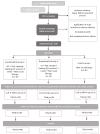Efficacy of a Rehabilitation Program Using Mirror Therapy and Cognitive Therapeutic Exercise on Upper Limb Functionality in Patients with Acute Stroke
- PMID: 38470680
- PMCID: PMC10931296
- DOI: 10.3390/healthcare12050569
Efficacy of a Rehabilitation Program Using Mirror Therapy and Cognitive Therapeutic Exercise on Upper Limb Functionality in Patients with Acute Stroke
Abstract
Applying evidence-based therapies in stroke rehabilitation plays a crucial role in this process, as they are supported by studies and results that demonstrate their effectiveness in improving functionality, such as mirror therapy (MT), cognitive therapeutic exercise (CTE), and task-oriented training. The aim of this study was to assess the effectiveness of MT and CTE combined with task-oriented training on the functionality, sensitivity, range, and pain of the affected upper limb in patients with acute stroke. A longitudinal multicenter study recruited a sample of 120 patients with acute stroke randomly and consecutively, meeting specific inclusion and exclusion criteria. They were randomly allocated into three groups: a control group only for task-oriented training (TOT) and two groups undergoing either MT or CTE, both combined with TOT. The overall functionality of the affected upper limb, specific functionality, sensitivity, range of motion, and pain were assessed using the Fugl-Meyer Assessment Upper Extremity (FMA-UE) scale validated for the Spanish population. An initial assessment was conducted before the intervention, a second assessment after completing the 20 sessions, and another three months later. ANCOVA analysis revealed statistically significant differences between the assessments and the experimental groups compared to the control group, indicating significant improvement in the overall functionality of the upper limb in these patients. However, no significant differences were observed between the two experimental groups. The conclusion drawn was that both therapeutic techniques are equally effective in treating functionality, sensitivity, range of motion, and pain in the upper limb following a stroke.
Keywords: acute stroke; cognitive therapeutic exercise; functionality; mirror therapy; non-pharmacological therapy; task-oriented training; upper limb.
Conflict of interest statement
The authors declare no conflicts of interest.
Figures
Similar articles
-
Effect of task-based mirror therapy on motor recovery of the upper extremity in chronic stroke patients: a pilot study.Top Stroke Rehabil. 2013 May-Jun;20(3):210-7. doi: 10.1310/tsr2003-210. Top Stroke Rehabil. 2013. PMID: 23841968
-
Comparison Between Movement-Based and Task-Based Mirror Therapies on Improving Upper Limb Functions in Patients With Stroke: A Pilot Randomized Controlled Trial.Front Neurol. 2019 Mar 26;10:288. doi: 10.3389/fneur.2019.00288. eCollection 2019. Front Neurol. 2019. PMID: 30972016 Free PMC article.
-
Feasibility, safety, and efficacy of task-oriented mirrored robotic training on upper-limb functions and activities of daily living in subacute poststroke patients: a pilot study.Eur J Phys Rehabil Med. 2023 Dec;59(6):660-668. doi: 10.23736/S1973-9087.23.08018-8. Epub 2023 Oct 23. Eur J Phys Rehabil Med. 2023. PMID: 37869761 Free PMC article. Clinical Trial.
-
Synergistic Effect of Combined Mirror Therapy on Upper Extremity in Patients With Stroke: A Systematic Review and Meta-Analysis.Front Neurol. 2020 Apr 2;11:155. doi: 10.3389/fneur.2020.00155. eCollection 2020. Front Neurol. 2020. PMID: 32300326 Free PMC article.
-
Effectiveness of task-specific training using assistive devices and task-specific usual care on upper limb performance after stroke: a systematic review and meta-analysis.Disabil Rehabil Assist Technol. 2023 Oct;18(7):1245-1258. doi: 10.1080/17483107.2021.2001061. Epub 2021 Nov 17. Disabil Rehabil Assist Technol. 2023. PMID: 34788166
Cited by
-
Design of upper limb muscle strength assessment system based on surface electromyography signals and joint motion.Front Neurol. 2024 Dec 13;15:1470759. doi: 10.3389/fneur.2024.1470759. eCollection 2024. Front Neurol. 2024. PMID: 39734626 Free PMC article.
-
The Benefits of Cognitive Therapeutic Exercise in Symptomatic Arnold-Chiari Syndrome Type I: A Case Report on Gait, Balance, and Pain Management.J Clin Med. 2024 Sep 18;13(18):5502. doi: 10.3390/jcm13185502. J Clin Med. 2024. PMID: 39336989 Free PMC article.
-
Sensor-Based Balance Training with Exergaming Feedback in Subjects with Chronic Stroke: A Pilot Randomized Controlled Trial.Brain Sci. 2024 Sep 13;14(9):917. doi: 10.3390/brainsci14090917. Brain Sci. 2024. PMID: 39335412 Free PMC article.
-
Novel Robotic Balloon-Based Device for Wrist-Extension Therapy of Hemiparesis Stroke Patients.Sensors (Basel). 2025 Feb 23;25(5):1360. doi: 10.3390/s25051360. Sensors (Basel). 2025. PMID: 40096113 Free PMC article.
-
[Cyberful-Virtual reality in arm and hand rehabilitation].Unfallchirurgie (Heidelb). 2025 Apr;128(4):278-282. doi: 10.1007/s00113-025-01537-2. Epub 2025 Mar 18. Unfallchirurgie (Heidelb). 2025. PMID: 40102242 Free PMC article. Review. German.
References
-
- González-Santos J., Rodríguez-Fernández P., Pardo-Hernández R., González-Bernal J.J., Fernández-Solana J., Santamaría-Peláez M. A Cross-Sectional Study: Determining Factors of Functional Independence and Quality of Life of Patients One Month after Having Suffered a Stroke. Int. J. Environ. Res. Public Health. 2023;20:995. doi: 10.3390/ijerph20020995. - DOI - PMC - PubMed
-
- Feigin V.L., Stark B.A., Johnson C.O., Roth G.A., Bisignano C., Abady G.G., Abbasifard M., Abbasi-Kangevari M., Abd-Allah F., Abedi V., et al. Global, regional, and national burden of stroke and its risk factors, 1990–2019: A systematic analysis for the Global Burden of Disease Study 2019. Lancet. Neurol. 2021;20:795–820. doi: 10.1016/S1474-4422(21)00252-0. - DOI - PMC - PubMed
LinkOut - more resources
Full Text Sources




